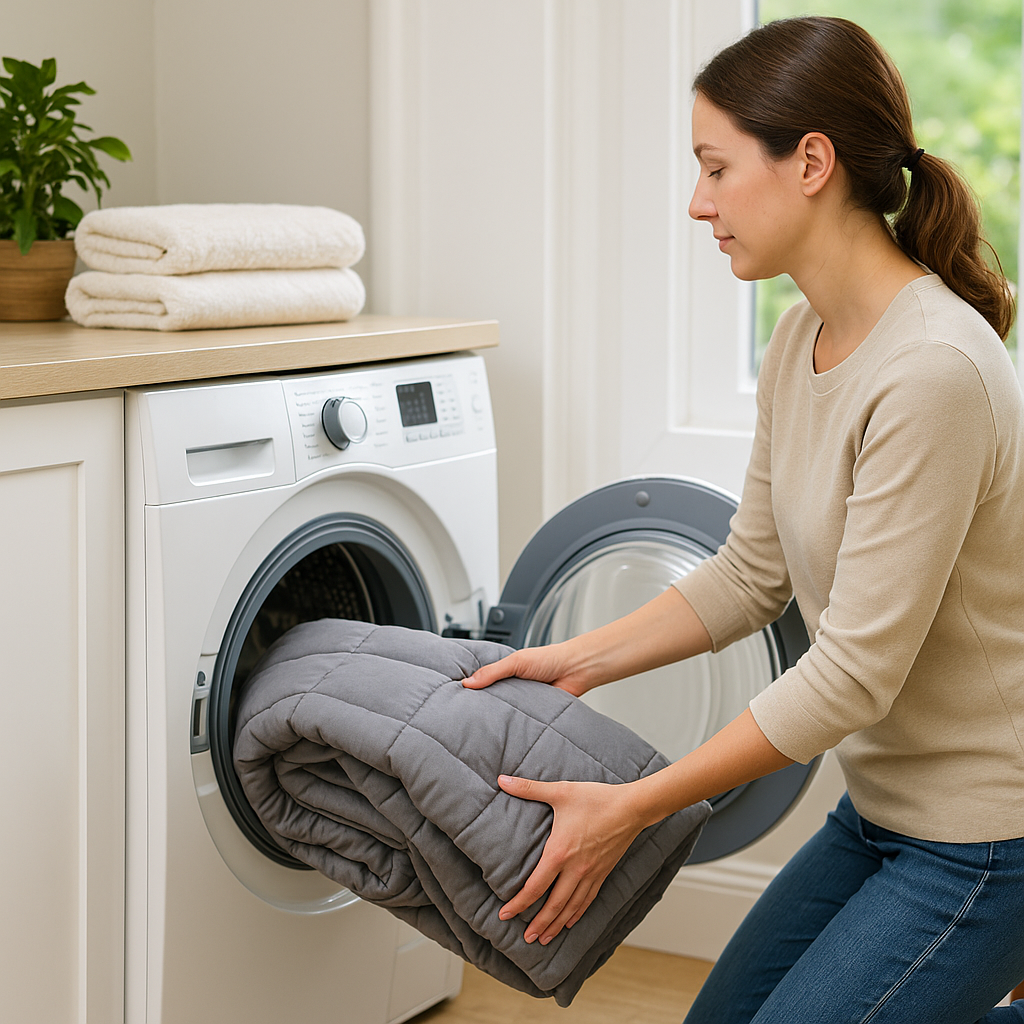How to Wash a Weighted Blanket: The Definitive Guide for 2025
Your weighted blanket is an investment in comfort and calm. But its heavy, delicate nature can make laundry day intimidating. This battle-tested guide provides everything you need to know to wash your weighted blanket safely, protecting both the blanket and your washing machine.
So, can you wash a weighted blanket? At Blanket Insider, it’s a question we get all the time. The answer is a resounding yes—if you do it correctly. Unlike a standard throw, a weighted blanket’s internal filling of glass beads or poly pellets requires a specific cleaning process to prevent clumping, ripping, or damage. Tossing it in the wash without a plan can lead to a lumpy, unusable mess.
We’ve washed countless weighted blankets, from light cotton models to heavy minky giants. We know what works, what doesn’t, and why. This is our definitive guide on how to wash a weighted blanket, designed to give you the confidence to clean yours effectively and safely.
The Quick Answer: Yes, But Follow These Rules
Most weighted blankets are washable. For the best results, follow these four non-negotiable rules:
- Always Read the Care Label First: This is your most important instruction manual.
- Use a Large, Front-Loading Washer: If your blanket is over 15 lbs, use a commercial machine at a laundromat.
- Wash on a Cold, Gentle Cycle: Use a mild detergent and wash the blanket alone.
- Air Dry Flat for Safety: This is the safest method. If the label allows, tumble dry on the lowest possible heat or an “air fluff” setting.
Pre-Wash Checklist: The 3 Steps Before You Start
A few minutes of preparation will save you from costly mistakes. Complete this checklist before your blanket goes anywhere near water.
🏷️ Step 1: Read the Care Label
The manufacturer’s tag is your ultimate guide. It will specify if the blanket is machine washable, the safe water temperature, and the recommended drying method. Do not deviate from these instructions.
🔬 Step 2: Identify Materials
Know what you’re cleaning. A cotton cover with glass beads can handle a machine wash. A wool cover or a blanket with organic fillers (like rice or sand) is likely spot-clean or hand-wash only to prevent mold and damage.
⚖️ Step 3: Check the Weight
This is crucial for your washing machine’s health. A wet weighted blanket is extremely heavy. If your blanket weighs more than 15-20 pounds, it’s too heavy for a standard home washer and must be washed in a large-capacity commercial machine.
The Washing Process: Machine vs. Hand Washing
If your blanket has a removable cover, wash it separately like a normal duvet. For the inner blanket, choose the method below based on your pre-wash check.
Machine Washing (for blankets <15 lbs)
- Use a Front-Loader: A top-loader’s central agitator can rip the blanket’s stitching.
- Wash Alone: This ensures a balanced spin cycle.
- Select a Gentle Cycle: Use cold or lukewarm water on a “delicate” or “hand wash” setting.
- Use Mild Detergent: Add a small amount of a gentle, bleach-free liquid detergent. Avoid fabric softeners.
- Add an Extra Rinse: This helps remove all soap residue from the dense material.
Hand Washing (for delicate or heavy blankets)
- Fill a Clean Bathtub: Use cool water and a small amount of mild detergent.
- Submerge & Soak: Gently agitate the blanket with your hands and let it soak for 30 minutes.
- Drain & Rinse: Drain the soapy water and refill with clean, cool water. Gently press on the blanket to rinse. Repeat until all suds are gone.
- Remove Excess Water: Do not wring or twist the blanket. Gently fold and press it to remove water. You can also roll it in large, dry towels to absorb moisture.
The Drying Process: Patience is a Virtue
This is the most critical stage. Improper drying can lead to mildew or damage the blanket’s filling.
Air Drying Is Always the Safest Method
Lay the blanket flat over a clean surface, several drying racks, or a sturdy clothesline. Flip it every few hours to ensure it dries evenly. This can take 24-48 hours, but it is the best way to protect your investment. If the care label allows for tumble drying, only use the lowest heat or “air fluff” setting. High heat can melt plastic pellets and weaken the fabric.
Our Recommended Cleaning Tools
Using the right products ensures a safe and effective clean without harsh chemicals.

Seventh Generation Free & Clear
This plant-based, hypoallergenic detergent is tough on dirt but gentle on fabrics and skin. Perfect for a deep clean without harsh chemicals.
Check Price on Amazon
Woolite Delicates
Ideal for hand washing or delicate cycles. Woolite is specifically formulated to protect fabrics and prevent damage, making it a safe choice for any washable blanket.
Check Price on Amazon
Large Mesh Laundry Bag
For smaller weighted blankets (like those for children), washing inside a large mesh bag can provide extra protection against snagging on the washer drum.
Check Price on AmazonCommon Mistakes to Avoid
Steer clear of these common pitfalls to keep your blanket in perfect condition.
A Note for Parents
While some older children benefit from weighted blankets under occupational therapist guidance, it’s crucial to know they are **not safe for infants or toddlers.** For information on infant-safe bedding, please consult our guide on when a baby can sleep with a blanket.
Frequently Asked Questions
Q: What if my blanket smells after washing?
This usually means it’s not fully dry on the inside. Let it air dry for another 24 hours. If the smell persists, you can sprinkle it with baking soda, let it sit for an hour, and then vacuum it off.
Q: How often should I wash the inner blanket?
If you use a removable duvet cover (and wash it regularly), you should only need to wash the inner weighted blanket 2-4 times per year, unless there is a major spill.
The Final Word: Care for Your Calm
Properly caring for your weighted blanket ensures it remains a clean, effective, and long-lasting tool for comfort and relaxation. While the process requires more care than a standard throw, it’s straightforward once you know the rules. Always prioritize the instructions on the care label, and when in doubt, choose the gentlest method possible.
This same principle of mindful care applies to all your comfort items, from a specialized heated blanket to the simple swaddle for a newborn, and even the blanket you take to the beach. By caring for them well, they can continue to bring you comfort, whether in use or stored neatly on a blanket ladder.

